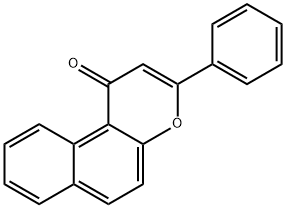DULCITOL
Synonym(s):5,6-Benzoflavone;beta-Naphthoflavone;BNF
- CAS NO.:6051-87-2
- Empirical Formula: C19H12O2
- Molecular Weight: 272.3
- MDL number: MFCD00004986
- EINECS: 227-958-4
- SAFETY DATA SHEET (SDS)
- Update Date: 2024-11-12 15:22:20

What is DULCITOL?
Chemical properties
SLIGHTLY BEIGE CRYSTALLINE POWDER
The Uses of DULCITOL
beta-Naphthoflavone is a Cytochrome P450 enzyme system inducer. It can also be used in biological study of novel dual-color luciferase reporter assay for simultaneous detection of estrogen and aryl hydrocarbon receptor activation.
What are the applications of Application
β-Naphthoflavone is a Cytochrome P450 enzyme system inducer
Definition
ChEBI: An extended flavonoid resulting from the formal fusion of a benzene ring with the f side of flavone.
General Description
β-Naphthoflavone is a polyaromatic hydrocarbon.
Biochem/physiol Actions
β-Naphthoflavone (BNF) is an exogenous ligand for aryl hydrocarbon receptor (AhR) in humans. It is an inducer of phase I detoxification enzymes (CYPs) and phase II enzymes (UDP-GTs) and NAD(P)H-dependent quinone oxyreductase-1(NQO1). It also induces cytochrome P450 (Cyp1a). BNF represses the expression of Duchenne muscular dystrophy gene, dystrophin (Dp)71 by altering the binding of the transcription factors.
Properties of DULCITOL
| Melting point: | 164-166 °C (lit.) |
| Boiling point: | 275-280 °C (1 mmHg) |
| Density | 1.1382 (rough estimate) |
| refractive index | 1.5510 (estimate) |
| storage temp. | 2-8°C |
| solubility | Chloroform (Slightly), Methanol (Slightly, Heated) |
| form | Crystalline Powder |
| color | yellow to tan |
| BRN | 18991 |
| CAS DataBase Reference | 6051-87-2(CAS DataBase Reference) |
Safety information for DULCITOL
| Signal word | Warning |
| Pictogram(s) |
 Exclamation Mark Irritant GHS07 |
| GHS Hazard Statements |
H315:Skin corrosion/irritation H319:Serious eye damage/eye irritation H335:Specific target organ toxicity, single exposure;Respiratory tract irritation |
| Precautionary Statement Codes |
P280:Wear protective gloves/protective clothing/eye protection/face protection. P304+P340:IF INHALED: Remove victim to fresh air and Keep at rest in a position comfortable for breathing. P305+P351+P338:IF IN EYES: Rinse cautiously with water for several minutes. Remove contact lenses, if present and easy to do. Continuerinsing. |
Computed Descriptors for DULCITOL
New Products
4-AMINO-TETRAHYDRO-PYRAN-4-CARBOXYLIC ACID HCL 4-(Dimethylamino)tetrahydro-2H-pyran-4-carbonitrile 4-Aminotetrahydropyran-4-carbonitrile Hydrochloride (R)-3-Aminobutanenitrile Hydrochloride 3-((Dimethylamino)methyl)-5-methylhexan-2-one oxalate 1,4-Dioxa-8-azaspiro[4.5]decane 5-Bromo-2-nitropyridine Nimesulide BP Aceclofenac IP/BP/EP Diclofenac Sodium IP/BP/EP/USP Mefenamic Acid IP/BP/EP/USP Ornidazole IP Diclofenac Potassium THOMAIND PAPER PH 2.0 TO 4.5 1 BOX BUFFER CAPSULE PH 9.2 - 10 CAP SODIUM CHLORIDE 0.1N CVS ALLOXAN MONOHYDRATE 98% PLATINUM 0.5% ON 3 MM ALUMINA PELLETS (TYPE 73) LITHIUM AAS SOLUTION 2-Bromo-1-(bromomethyl)-3-chloro-5-nitrobenzene 2-Bromo-3-nitroaniline N-(3-Hydroxypropyl)-N-methylacetamide 3-Bromo-6-chloropyridazine 4-ethyl-3-nitrobenzoic acidRelated products of tetrahydrofuran








You may like
-
 β-Naphthoflavone CAS 6051-87-2View Details
β-Naphthoflavone CAS 6051-87-2View Details
6051-87-2 -
 Beta-naphthoflavone 95% CAS 6051-87-2View Details
Beta-naphthoflavone 95% CAS 6051-87-2View Details
6051-87-2 -
 β-Naphthoflavone CAS 6051-87-2View Details
β-Naphthoflavone CAS 6051-87-2View Details
6051-87-2 -
 1823368-42-8 98%View Details
1823368-42-8 98%View Details
1823368-42-8 -
 2-(3-(tert-butyl)phenoxy)-2-methylpropanoic acid 1307449-08-6 98%View Details
2-(3-(tert-butyl)phenoxy)-2-methylpropanoic acid 1307449-08-6 98%View Details
1307449-08-6 -
 Ethyl 3-(furan-2-yl)-3-hydroxypropanoate 25408-95-1 98%View Details
Ethyl 3-(furan-2-yl)-3-hydroxypropanoate 25408-95-1 98%View Details
25408-95-1 -
 2-Chloro-5-fluoro-1-methoxy-3-methylbenzene 98%View Details
2-Chloro-5-fluoro-1-methoxy-3-methylbenzene 98%View Details
1805639-70-6 -
 Lithium ClavulanateView Details
Lithium ClavulanateView Details
61177-44-4